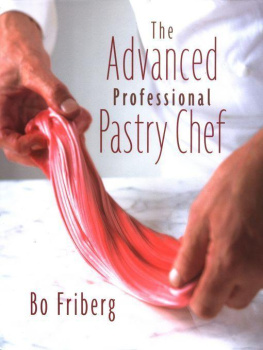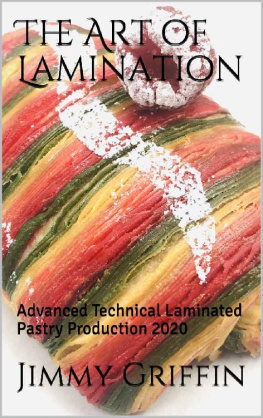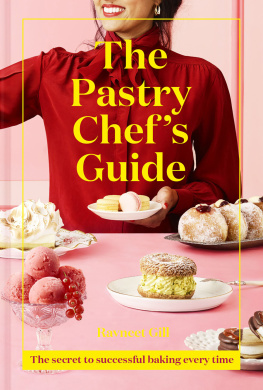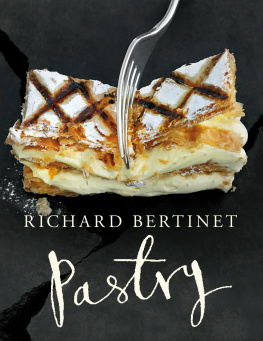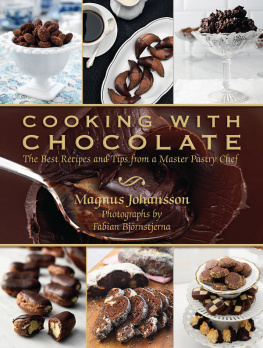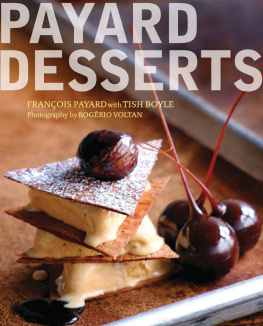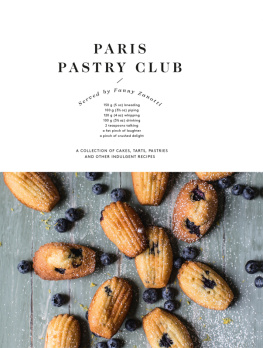Table of Contents
Charts, cake decorating designs, chocolate figurines, marzipan designs, and templates drawn and copyrighted by Bo Friberg.
All other illustrations designed by Bo Friberg and Amy Kemp Friberg and drawn by Joyce Hasselbeck Fowler; copyrighted by John Wiley & Sons, Inc.
Front jacket, back jacket (top), case cover photos, and interior halftones produced and copyrighted by Amos Chan.
All other color photographs, including jacket spine and back jacket (bottom), produced and copyrighted by Bo Friberg with food styling by Bo Friberg and Amy Kemp Friberg.
This book is printed on acid-free paper.
Copyright @ 2003 by John Wiley & Sons, Inc.All rights reserved.
Published by John Wiley & Sons, Inc., Hoboken, New Jersey.
Published simultaneously in Canada.
No part of this publication may be reproduced, stored in a retrieval system, or transmitted in any form or by any means, electronic, mechanical, photocopying, recording, scanning, or otherwise, except as permitted under Section 107 or 108 of the 1976 United States Copyright Act, without either the prior written permission of the Publisher, or authorization through payment of the appropriate per-copy fee to the Copyright Clearance Center, Inc., 222 Rosewood Drive, Danvers, MA 01923, (978) 750-8400, fax (978) 750-4470, or on the web at www.copyright.com. Requests to the Publisher for permission should be addressed to the Permissions Department, John Wiley & Sons, Inc., 1 1 1 River Street, Hoboken, NJ 07030, (201) 748-6011, fax (201) 748-6008, e-mail; permcoordinator@wiley.com.
Limit of Liability/Disclaimer of Warranty: While the publisher and author have used their best efforts in preparing this book, they make no representations or warranties with respect to the accuracy or completeness of the contents of this book and specifically disclaim any implied warranties of merchantability or fitness for a particular purpose. No warranty may be created or extended by sales representatives or written sales materials. The advice and strategies contained herein may not be suitable for your situation. You should consult with a professional where appropriate. Neither the publisher nor author shall be liable for any loss of profit or any other commercial damages, including but not limited to special, incidental, consequential, or other damages.
For general information on our other products and services or for technical support, please contact our Customer Care Department within the United States at (800) 762-2974, outside the United States at (317) 572-3993 or fax (317) 572-4002.
Wiley also publishes its books in a variety of electronic formats. Some content that appears in print may not be available in electronic books. For more information about Wiley products, visit our web site at www.wiley.com.
Library of Congress Cataloging-in-Publication Data:
ISBN: 0-471-35926-2
Printed in the United States of America
Book design by Richard Oriolo
10 9 8 7 6 5 4 3 2 1
PREFACE
The decision to become a pastry chef may be a one-time occurrence, but the realization of that goal continues throughout ones career. A good chef is constantly evolving trying new things, learning different techniques, and improving his or her skills. The old saying its best to leave well enough alone does not apply in our field. Rather than being content with something that is just good enough, we must always strive for improvement to stay competitive. We learn from our failures as well as our successes, and many of us share both with others in our profession. I have always offered all of my knowledge to my colleagues and my students while continuing to learn, experiment, and work on new projects. The idea of continually looking for an original way to prepare a recipe or trying a fresh approach with a classic dessert presentation, for example, was the impetus behind the three revisions of The Professional Pastry Chef over the last 18 years, and now the creation of this new volume.
When the time came to revise The Professional Pastry Chef, Third Edition , it was clear that we needed to divide the text into two volumes. The first of the two books was The Professional Pastry Chef Fourth Edition: Fundamentals of Baking and Pastry . The fundamentals volume contains recipes for yeast breads, flatbreads, cookies, basic individual pastries and decorated cakes, breakfast breads, doughs, ice creams, sauces, syrups, fillings, custards and puddings, plated desserts, and an introduction to chocolate work and decorating. This book, The Advanced Professional Pastry Chef , contains some revised material from the third edition which reflects industry trends, suggestions from students and colleagues, and my own improvements, plus dozens of new recipes, photographs, and templates. As in the companion volume, here too you will find chapters on decorated cakes, plated desserts, and individual pastries, but in this book the recipes are more complex. Further, this text features a much more comprehensive chocolate section, as well as chapters dedicated to the more specialized areas of pastry such as wedding cakes, frozen desserts, light desserts, modernist desserts, holiday classics, sugarwork, marzipan, and advanced decorating techniques.
While the majority of the recipes in this book are aimed at the more experienced chef who has mastered the fundamentals, many simple and easy-to-prepare recipes are included as well most notably in the chapters for light desserts, frozen desserts, and holiday classics and favorites, as these chapters are not included in the companion volume, meaning that all of my recipes for these desserts are found here.
Many culinary schools have implemented advanced pastry courses for the same reason that the third edition of my book became two volumes: There is simply too much information required for todays pastry chef to fit all of it into a single class or a single book. As the field of baking and pastry grows to new heights, advanced techniques are becoming more and more important.
Over the past few decades the general public has become much more educated about all types of food preparation, and the interest in dining out has never been higher. More importantly, from our perspective, the publics never-ending love of sweets has created an increased demand for top pastry chefs. Today, more consumers than ever before consider dessert to be a must have when dining out. What was once often an afterthought or an optional part of the meal has become an important source of revenue for restaurateurs. With desserts in many fine restaurants priced at the same level as first course selections, it is no longer enough to simply place a slice of cake or a serving of custard on a plate and accompany it with a pool of sauce no matter how good the combination may taste. When the customer has made the kind of monetary investment required for an evening out in an upscale restaurant today, he expects us to put on a bit of a show at the end of the meal. To create a dessert of this caliber, it is necessary for the plate to be finished to order, with the pastry chef artfully arranging several prepared components together with complementary sauces and/or decorating syrups, and garnishes made of sugar, chocolate, or tuile paste, for example. Todays dessert menus are often every bit as elaborate as the menus for the other courses, and they generally recognize the pastry chef that heads the department. Although this book covers much more than just recipes for desserts to be served after a meal, that element is undoubtedly the most important subject for a restaurant pastry chef to master.

